Educational Psychology Report: Adult Learning and Motivation Theories
VerifiedAdded on 2020/06/04
|8
|1779
|57
Report
AI Summary
This educational psychology report delves into the crucial role of educational psychology in adult learning processes. It defines Andragogy, outlining its principles in adult education, and explores Maslow's Hierarchy of Needs, illustrating its organizational structure and application in teaching. The report defines motivation, differentiating between internal and external factors, and examines the teacher's role in motivating students, including various approaches such as appreciation and encouragement. The report also examines the effect of motivation on the teaching process. The report concludes by emphasizing the importance of motivation for effective adult education and the practical applications of Maslow's theory and motivational techniques in the classroom.
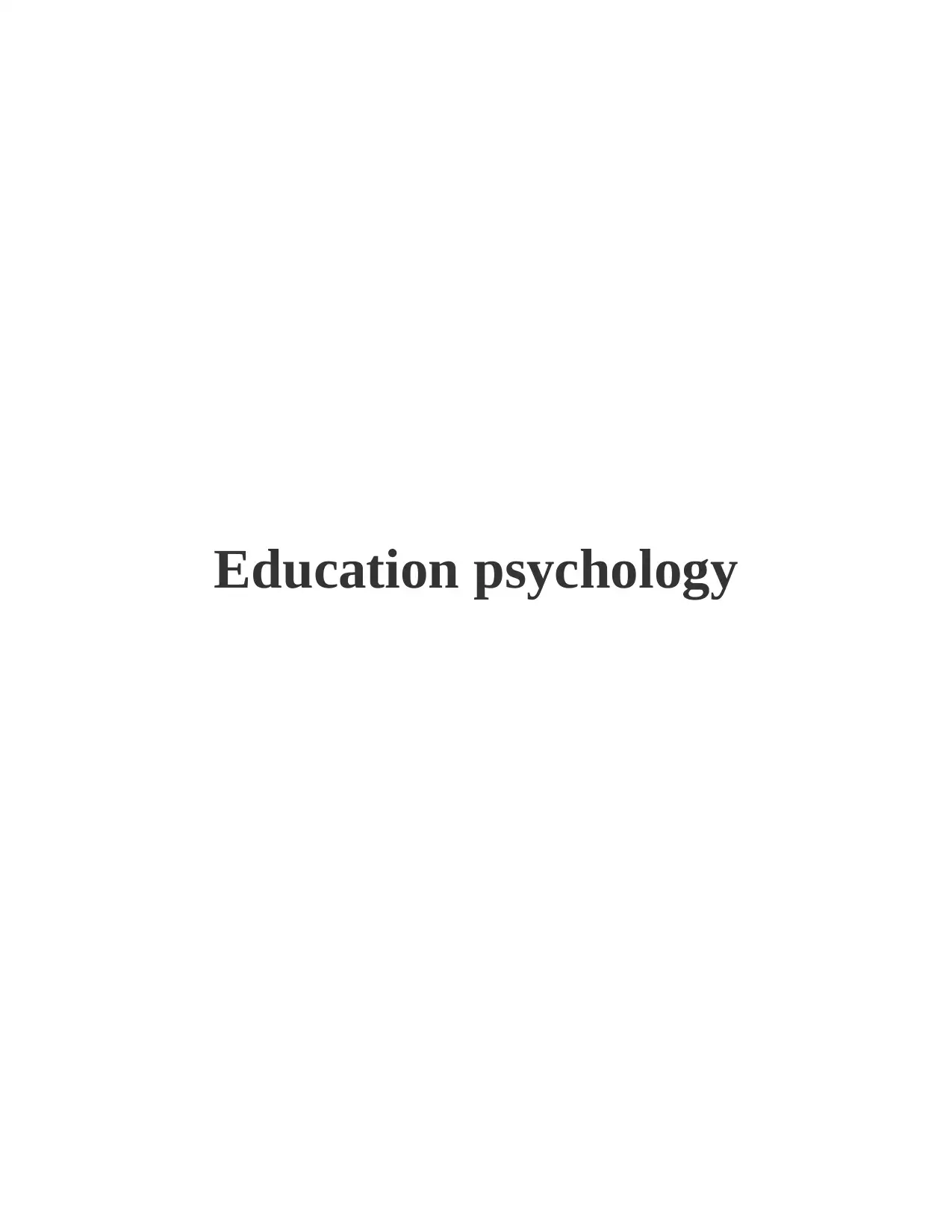
Education psychology
Paraphrase This Document
Need a fresh take? Get an instant paraphrase of this document with our AI Paraphraser
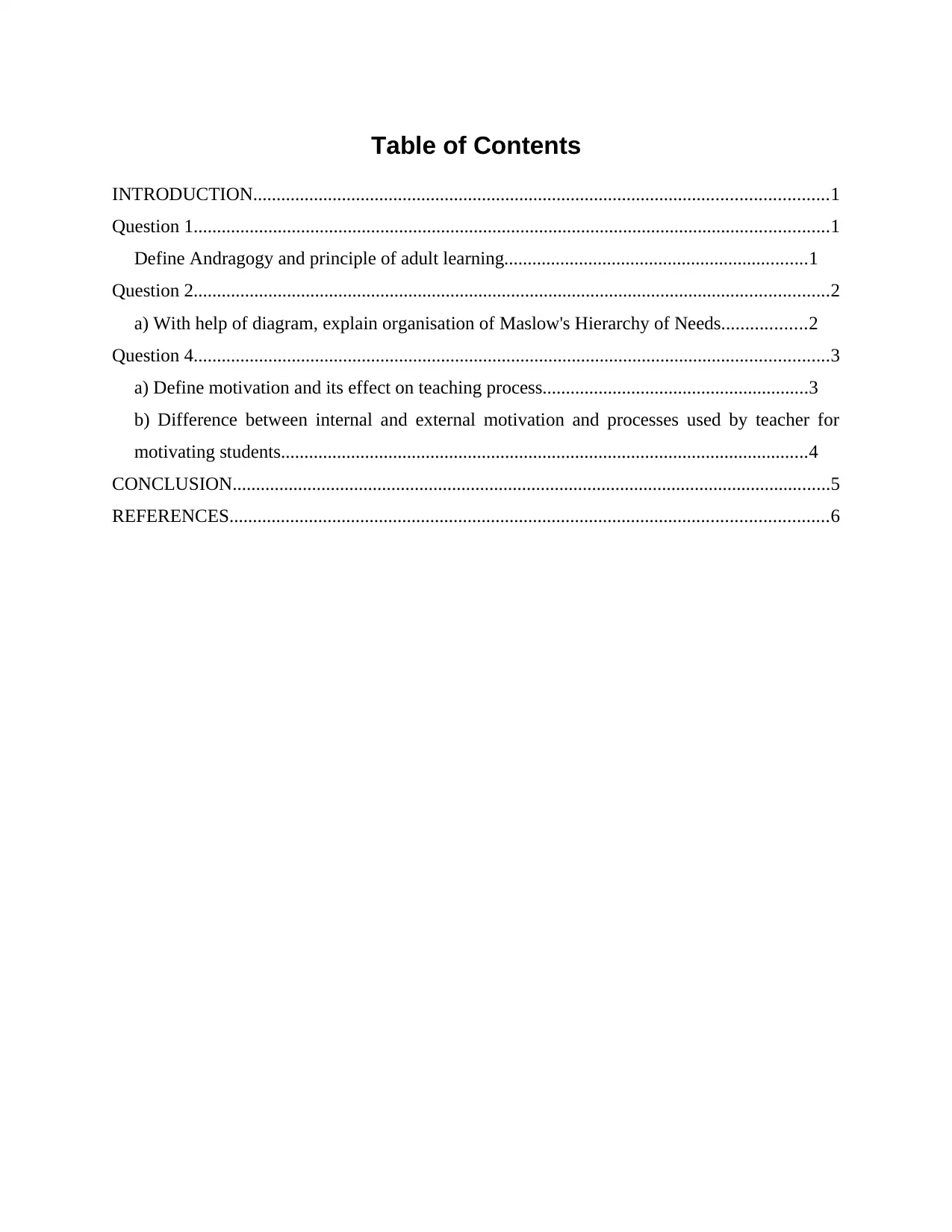
Table of Contents
INTRODUCTION...........................................................................................................................1
Question 1........................................................................................................................................1
Define Andragogy and principle of adult learning.................................................................1
Question 2........................................................................................................................................2
a) With help of diagram, explain organisation of Maslow's Hierarchy of Needs..................2
Question 4........................................................................................................................................3
a) Define motivation and its effect on teaching process.........................................................3
b) Difference between internal and external motivation and processes used by teacher for
motivating students.................................................................................................................4
CONCLUSION................................................................................................................................5
REFERENCES................................................................................................................................6
INTRODUCTION...........................................................................................................................1
Question 1........................................................................................................................................1
Define Andragogy and principle of adult learning.................................................................1
Question 2........................................................................................................................................2
a) With help of diagram, explain organisation of Maslow's Hierarchy of Needs..................2
Question 4........................................................................................................................................3
a) Define motivation and its effect on teaching process.........................................................3
b) Difference between internal and external motivation and processes used by teacher for
motivating students.................................................................................................................4
CONCLUSION................................................................................................................................5
REFERENCES................................................................................................................................6
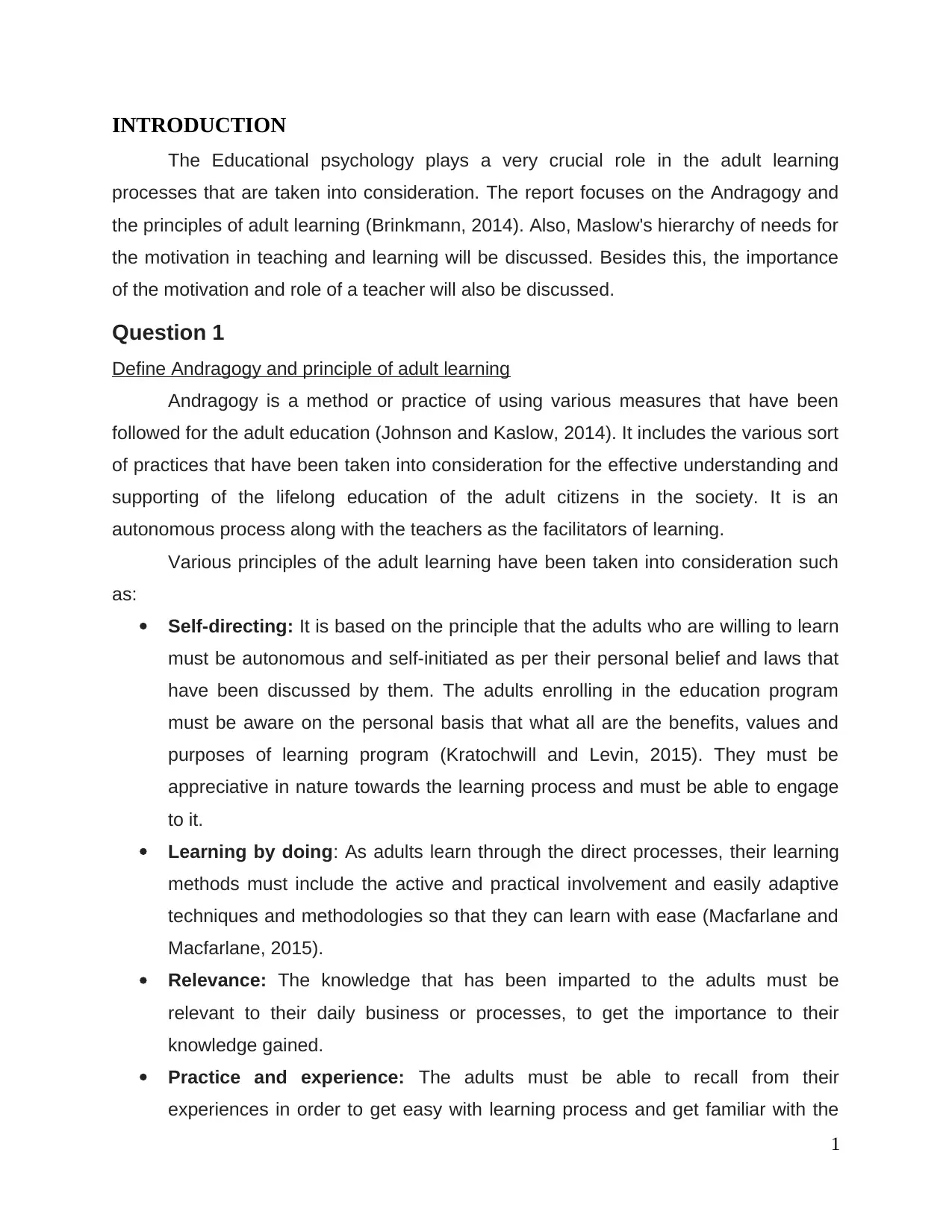
INTRODUCTION
The Educational psychology plays a very crucial role in the adult learning
processes that are taken into consideration. The report focuses on the Andragogy and
the principles of adult learning (Brinkmann, 2014). Also, Maslow's hierarchy of needs for
the motivation in teaching and learning will be discussed. Besides this, the importance
of the motivation and role of a teacher will also be discussed.
Question 1
Define Andragogy and principle of adult learning
Andragogy is a method or practice of using various measures that have been
followed for the adult education (Johnson and Kaslow, 2014). It includes the various sort
of practices that have been taken into consideration for the effective understanding and
supporting of the lifelong education of the adult citizens in the society. It is an
autonomous process along with the teachers as the facilitators of learning.
Various principles of the adult learning have been taken into consideration such
as:
Self-directing: It is based on the principle that the adults who are willing to learn
must be autonomous and self-initiated as per their personal belief and laws that
have been discussed by them. The adults enrolling in the education program
must be aware on the personal basis that what all are the benefits, values and
purposes of learning program (Kratochwill and Levin, 2015). They must be
appreciative in nature towards the learning process and must be able to engage
to it.
Learning by doing: As adults learn through the direct processes, their learning
methods must include the active and practical involvement and easily adaptive
techniques and methodologies so that they can learn with ease (Macfarlane and
Macfarlane, 2015).
Relevance: The knowledge that has been imparted to the adults must be
relevant to their daily business or processes, to get the importance to their
knowledge gained.
Practice and experience: The adults must be able to recall from their
experiences in order to get easy with learning process and get familiar with the
1
The Educational psychology plays a very crucial role in the adult learning
processes that are taken into consideration. The report focuses on the Andragogy and
the principles of adult learning (Brinkmann, 2014). Also, Maslow's hierarchy of needs for
the motivation in teaching and learning will be discussed. Besides this, the importance
of the motivation and role of a teacher will also be discussed.
Question 1
Define Andragogy and principle of adult learning
Andragogy is a method or practice of using various measures that have been
followed for the adult education (Johnson and Kaslow, 2014). It includes the various sort
of practices that have been taken into consideration for the effective understanding and
supporting of the lifelong education of the adult citizens in the society. It is an
autonomous process along with the teachers as the facilitators of learning.
Various principles of the adult learning have been taken into consideration such
as:
Self-directing: It is based on the principle that the adults who are willing to learn
must be autonomous and self-initiated as per their personal belief and laws that
have been discussed by them. The adults enrolling in the education program
must be aware on the personal basis that what all are the benefits, values and
purposes of learning program (Kratochwill and Levin, 2015). They must be
appreciative in nature towards the learning process and must be able to engage
to it.
Learning by doing: As adults learn through the direct processes, their learning
methods must include the active and practical involvement and easily adaptive
techniques and methodologies so that they can learn with ease (Macfarlane and
Macfarlane, 2015).
Relevance: The knowledge that has been imparted to the adults must be
relevant to their daily business or processes, to get the importance to their
knowledge gained.
Practice and experience: The adults must be able to recall from their
experiences in order to get easy with learning process and get familiar with the
1
⊘ This is a preview!⊘
Do you want full access?
Subscribe today to unlock all pages.

Trusted by 1+ million students worldwide
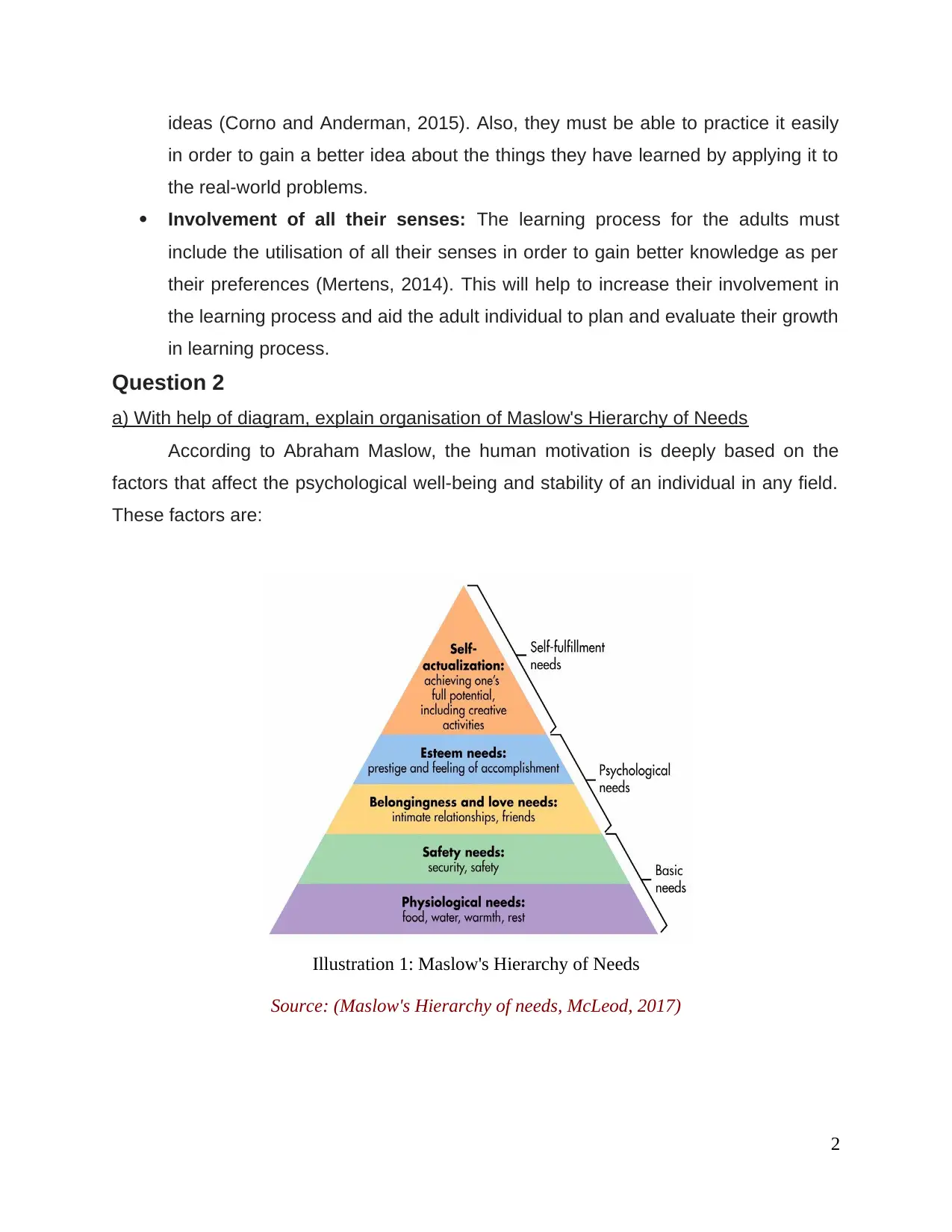
ideas (Corno and Anderman, 2015). Also, they must be able to practice it easily
in order to gain a better idea about the things they have learned by applying it to
the real-world problems.
Involvement of all their senses: The learning process for the adults must
include the utilisation of all their senses in order to gain better knowledge as per
their preferences (Mertens, 2014). This will help to increase their involvement in
the learning process and aid the adult individual to plan and evaluate their growth
in learning process.
Question 2
a) With help of diagram, explain organisation of Maslow's Hierarchy of Needs
According to Abraham Maslow, the human motivation is deeply based on the
factors that affect the psychological well-being and stability of an individual in any field.
These factors are:
2
Illustration 1: Maslow's Hierarchy of Needs
Source: (Maslow's Hierarchy of needs, McLeod, 2017)
in order to gain a better idea about the things they have learned by applying it to
the real-world problems.
Involvement of all their senses: The learning process for the adults must
include the utilisation of all their senses in order to gain better knowledge as per
their preferences (Mertens, 2014). This will help to increase their involvement in
the learning process and aid the adult individual to plan and evaluate their growth
in learning process.
Question 2
a) With help of diagram, explain organisation of Maslow's Hierarchy of Needs
According to Abraham Maslow, the human motivation is deeply based on the
factors that affect the psychological well-being and stability of an individual in any field.
These factors are:
2
Illustration 1: Maslow's Hierarchy of Needs
Source: (Maslow's Hierarchy of needs, McLeod, 2017)
Paraphrase This Document
Need a fresh take? Get an instant paraphrase of this document with our AI Paraphraser
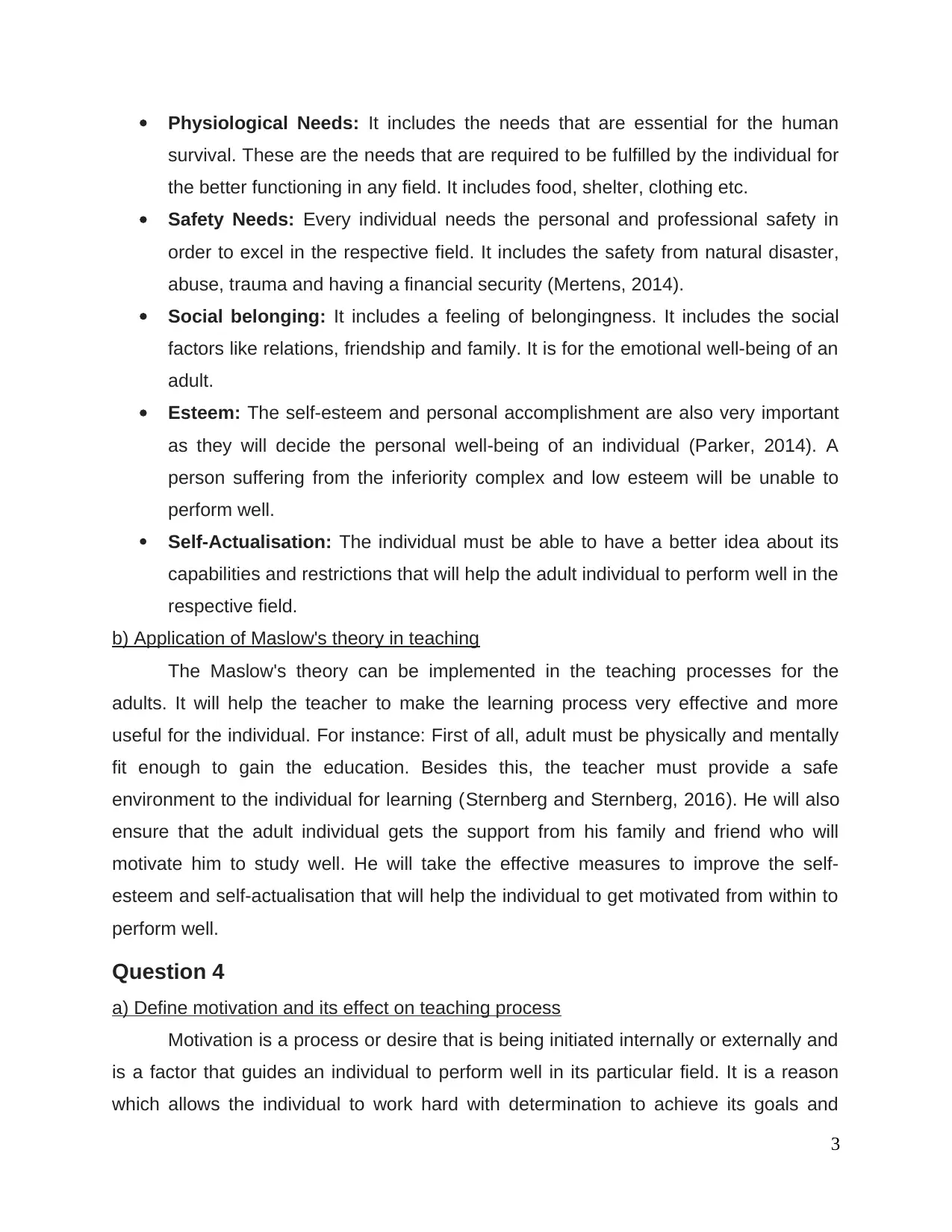
Physiological Needs: It includes the needs that are essential for the human
survival. These are the needs that are required to be fulfilled by the individual for
the better functioning in any field. It includes food, shelter, clothing etc.
Safety Needs: Every individual needs the personal and professional safety in
order to excel in the respective field. It includes the safety from natural disaster,
abuse, trauma and having a financial security (Mertens, 2014).
Social belonging: It includes a feeling of belongingness. It includes the social
factors like relations, friendship and family. It is for the emotional well-being of an
adult.
Esteem: The self-esteem and personal accomplishment are also very important
as they will decide the personal well-being of an individual (Parker, 2014). A
person suffering from the inferiority complex and low esteem will be unable to
perform well.
Self-Actualisation: The individual must be able to have a better idea about its
capabilities and restrictions that will help the adult individual to perform well in the
respective field.
b) Application of Maslow's theory in teaching
The Maslow's theory can be implemented in the teaching processes for the
adults. It will help the teacher to make the learning process very effective and more
useful for the individual. For instance: First of all, adult must be physically and mentally
fit enough to gain the education. Besides this, the teacher must provide a safe
environment to the individual for learning (Sternberg and Sternberg, 2016). He will also
ensure that the adult individual gets the support from his family and friend who will
motivate him to study well. He will take the effective measures to improve the self-
esteem and self-actualisation that will help the individual to get motivated from within to
perform well.
Question 4
a) Define motivation and its effect on teaching process
Motivation is a process or desire that is being initiated internally or externally and
is a factor that guides an individual to perform well in its particular field. It is a reason
which allows the individual to work hard with determination to achieve its goals and
3
survival. These are the needs that are required to be fulfilled by the individual for
the better functioning in any field. It includes food, shelter, clothing etc.
Safety Needs: Every individual needs the personal and professional safety in
order to excel in the respective field. It includes the safety from natural disaster,
abuse, trauma and having a financial security (Mertens, 2014).
Social belonging: It includes a feeling of belongingness. It includes the social
factors like relations, friendship and family. It is for the emotional well-being of an
adult.
Esteem: The self-esteem and personal accomplishment are also very important
as they will decide the personal well-being of an individual (Parker, 2014). A
person suffering from the inferiority complex and low esteem will be unable to
perform well.
Self-Actualisation: The individual must be able to have a better idea about its
capabilities and restrictions that will help the adult individual to perform well in the
respective field.
b) Application of Maslow's theory in teaching
The Maslow's theory can be implemented in the teaching processes for the
adults. It will help the teacher to make the learning process very effective and more
useful for the individual. For instance: First of all, adult must be physically and mentally
fit enough to gain the education. Besides this, the teacher must provide a safe
environment to the individual for learning (Sternberg and Sternberg, 2016). He will also
ensure that the adult individual gets the support from his family and friend who will
motivate him to study well. He will take the effective measures to improve the self-
esteem and self-actualisation that will help the individual to get motivated from within to
perform well.
Question 4
a) Define motivation and its effect on teaching process
Motivation is a process or desire that is being initiated internally or externally and
is a factor that guides an individual to perform well in its particular field. It is a reason
which allows the individual to work hard with determination to achieve its goals and
3
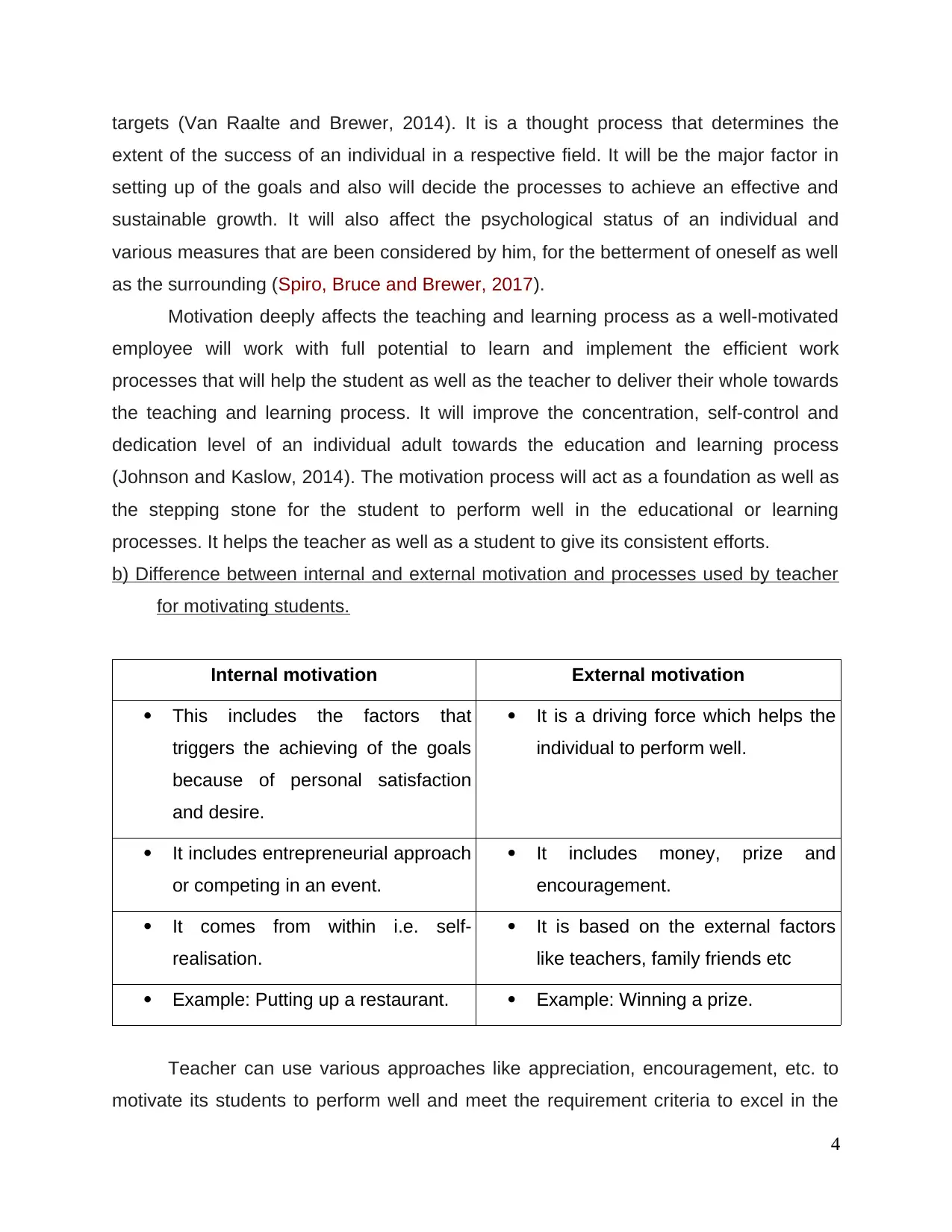
targets (Van Raalte and Brewer, 2014). It is a thought process that determines the
extent of the success of an individual in a respective field. It will be the major factor in
setting up of the goals and also will decide the processes to achieve an effective and
sustainable growth. It will also affect the psychological status of an individual and
various measures that are been considered by him, for the betterment of oneself as well
as the surrounding (Spiro, Bruce and Brewer, 2017).
Motivation deeply affects the teaching and learning process as a well-motivated
employee will work with full potential to learn and implement the efficient work
processes that will help the student as well as the teacher to deliver their whole towards
the teaching and learning process. It will improve the concentration, self-control and
dedication level of an individual adult towards the education and learning process
(Johnson and Kaslow, 2014). The motivation process will act as a foundation as well as
the stepping stone for the student to perform well in the educational or learning
processes. It helps the teacher as well as a student to give its consistent efforts.
b) Difference between internal and external motivation and processes used by teacher
for motivating students.
Internal motivation External motivation
This includes the factors that
triggers the achieving of the goals
because of personal satisfaction
and desire.
It is a driving force which helps the
individual to perform well.
It includes entrepreneurial approach
or competing in an event.
It includes money, prize and
encouragement.
It comes from within i.e. self-
realisation.
It is based on the external factors
like teachers, family friends etc
Example: Putting up a restaurant. Example: Winning a prize.
Teacher can use various approaches like appreciation, encouragement, etc. to
motivate its students to perform well and meet the requirement criteria to excel in the
4
extent of the success of an individual in a respective field. It will be the major factor in
setting up of the goals and also will decide the processes to achieve an effective and
sustainable growth. It will also affect the psychological status of an individual and
various measures that are been considered by him, for the betterment of oneself as well
as the surrounding (Spiro, Bruce and Brewer, 2017).
Motivation deeply affects the teaching and learning process as a well-motivated
employee will work with full potential to learn and implement the efficient work
processes that will help the student as well as the teacher to deliver their whole towards
the teaching and learning process. It will improve the concentration, self-control and
dedication level of an individual adult towards the education and learning process
(Johnson and Kaslow, 2014). The motivation process will act as a foundation as well as
the stepping stone for the student to perform well in the educational or learning
processes. It helps the teacher as well as a student to give its consistent efforts.
b) Difference between internal and external motivation and processes used by teacher
for motivating students.
Internal motivation External motivation
This includes the factors that
triggers the achieving of the goals
because of personal satisfaction
and desire.
It is a driving force which helps the
individual to perform well.
It includes entrepreneurial approach
or competing in an event.
It includes money, prize and
encouragement.
It comes from within i.e. self-
realisation.
It is based on the external factors
like teachers, family friends etc
Example: Putting up a restaurant. Example: Winning a prize.
Teacher can use various approaches like appreciation, encouragement, etc. to
motivate its students to perform well and meet the requirement criteria to excel in the
4
⊘ This is a preview!⊘
Do you want full access?
Subscribe today to unlock all pages.

Trusted by 1+ million students worldwide

education (Mertens, 2014). This will not only improve the student’s performance but
also increase his/her self-confidence.
CONCLUSION
Thus, from the report it can be concluded that motivation is very necessary for
the improvement of the education to an adult. The Maslow's theory helps the person to
get an idea of his/her needs. Besides this, the teachers will adopt various motivational
factors to motivate students.
5
also increase his/her self-confidence.
CONCLUSION
Thus, from the report it can be concluded that motivation is very necessary for
the improvement of the education to an adult. The Maslow's theory helps the person to
get an idea of his/her needs. Besides this, the teachers will adopt various motivational
factors to motivate students.
5
Paraphrase This Document
Need a fresh take? Get an instant paraphrase of this document with our AI Paraphraser
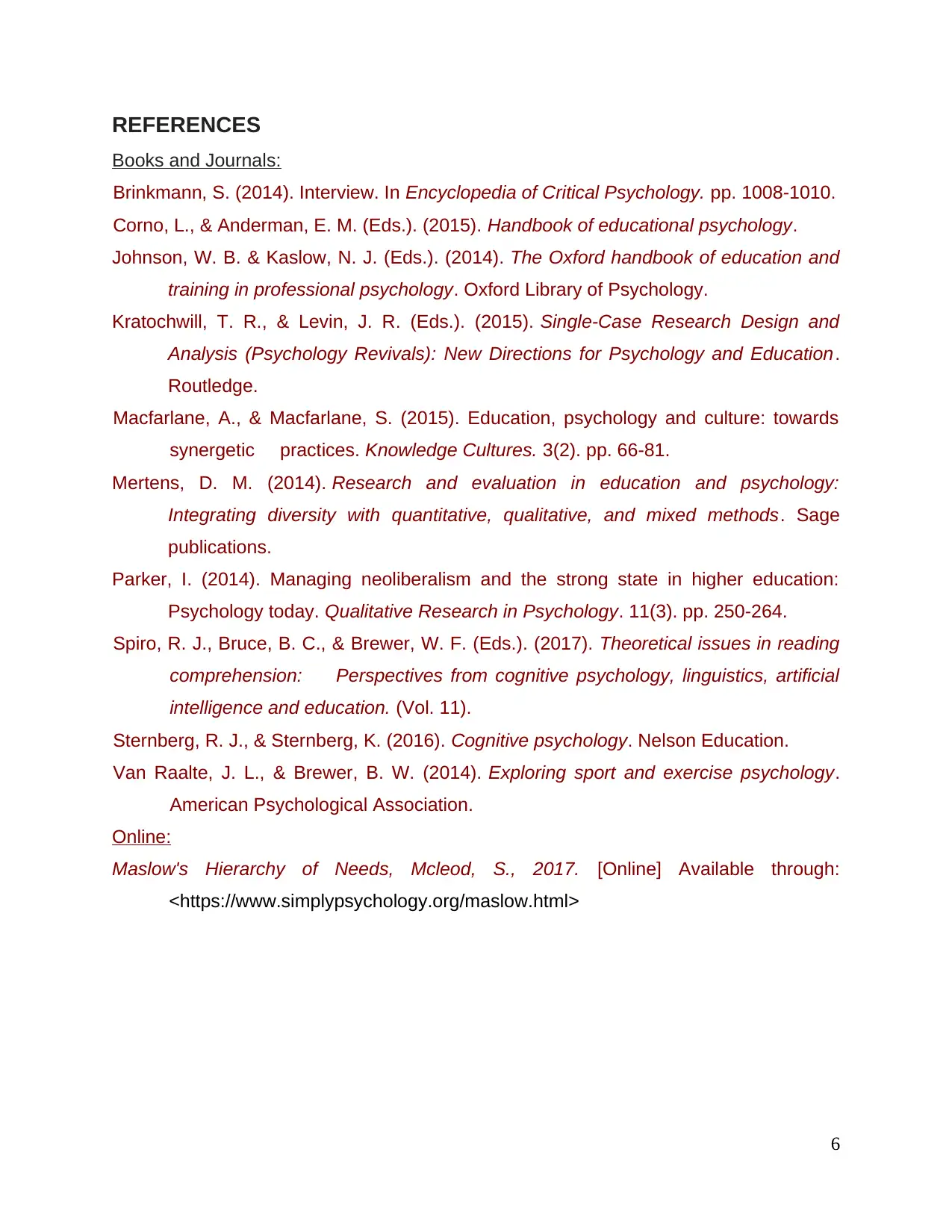
REFERENCES
Books and Journals:
Brinkmann, S. (2014). Interview. In Encyclopedia of Critical Psychology. pp. 1008-1010.
Corno, L., & Anderman, E. M. (Eds.). (2015). Handbook of educational psychology.
Johnson, W. B. & Kaslow, N. J. (Eds.). (2014). The Oxford handbook of education and
training in professional psychology. Oxford Library of Psychology.
Kratochwill, T. R., & Levin, J. R. (Eds.). (2015). Single-Case Research Design and
Analysis (Psychology Revivals): New Directions for Psychology and Education.
Routledge.
Macfarlane, A., & Macfarlane, S. (2015). Education, psychology and culture: towards
synergetic practices. Knowledge Cultures. 3(2). pp. 66-81.
Mertens, D. M. (2014). Research and evaluation in education and psychology:
Integrating diversity with quantitative, qualitative, and mixed methods. Sage
publications.
Parker, I. (2014). Managing neoliberalism and the strong state in higher education:
Psychology today. Qualitative Research in Psychology. 11(3). pp. 250-264.
Spiro, R. J., Bruce, B. C., & Brewer, W. F. (Eds.). (2017). Theoretical issues in reading
comprehension: Perspectives from cognitive psychology, linguistics, artificial
intelligence and education. (Vol. 11).
Sternberg, R. J., & Sternberg, K. (2016). Cognitive psychology. Nelson Education.
Van Raalte, J. L., & Brewer, B. W. (2014). Exploring sport and exercise psychology.
American Psychological Association.
Online:
Maslow's Hierarchy of Needs, Mcleod, S., 2017. [Online] Available through:
<https://www.simplypsychology.org/maslow.html>
6
Books and Journals:
Brinkmann, S. (2014). Interview. In Encyclopedia of Critical Psychology. pp. 1008-1010.
Corno, L., & Anderman, E. M. (Eds.). (2015). Handbook of educational psychology.
Johnson, W. B. & Kaslow, N. J. (Eds.). (2014). The Oxford handbook of education and
training in professional psychology. Oxford Library of Psychology.
Kratochwill, T. R., & Levin, J. R. (Eds.). (2015). Single-Case Research Design and
Analysis (Psychology Revivals): New Directions for Psychology and Education.
Routledge.
Macfarlane, A., & Macfarlane, S. (2015). Education, psychology and culture: towards
synergetic practices. Knowledge Cultures. 3(2). pp. 66-81.
Mertens, D. M. (2014). Research and evaluation in education and psychology:
Integrating diversity with quantitative, qualitative, and mixed methods. Sage
publications.
Parker, I. (2014). Managing neoliberalism and the strong state in higher education:
Psychology today. Qualitative Research in Psychology. 11(3). pp. 250-264.
Spiro, R. J., Bruce, B. C., & Brewer, W. F. (Eds.). (2017). Theoretical issues in reading
comprehension: Perspectives from cognitive psychology, linguistics, artificial
intelligence and education. (Vol. 11).
Sternberg, R. J., & Sternberg, K. (2016). Cognitive psychology. Nelson Education.
Van Raalte, J. L., & Brewer, B. W. (2014). Exploring sport and exercise psychology.
American Psychological Association.
Online:
Maslow's Hierarchy of Needs, Mcleod, S., 2017. [Online] Available through:
<https://www.simplypsychology.org/maslow.html>
6
1 out of 8
Related Documents
Your All-in-One AI-Powered Toolkit for Academic Success.
+13062052269
info@desklib.com
Available 24*7 on WhatsApp / Email
![[object Object]](/_next/static/media/star-bottom.7253800d.svg)
Unlock your academic potential
Copyright © 2020–2025 A2Z Services. All Rights Reserved. Developed and managed by ZUCOL.




